From toilet to table
This one is about food history, and maybe about hope.
I will drop a quick note here that I've got the collection of my favourite pieces from this year's Flash Fiction February challenge are available here for one US dollar, if you're interested.
I don't know what classy people do for bathroom reading material. I've known folks who think if you're in there long enough to read you're doing it wrong, but also they were only children who didn't know that the bathroom is (sometimes, not always) one of the few places one can escape. In a world of phones, I am guessing the basket of dusty magazines is a thing of the past, but it does look like that old standby, Uncle John's Bathroom Reader is still going, on it's 38th edition? Dang.
We had a copy of the 1997 Uncle John's Giant 10th Anniversary Bathroom Reader, which I read often outside of the toilet. You know how there are books that are designed to be flipped through, rather than read cover to cover? Cool fact compendiums, recipe books, anything more reference-y. Well I read them cover to cover. I love a cool fact, I'll just take them in a firehose, no need to give me just a couple themed ones at once.
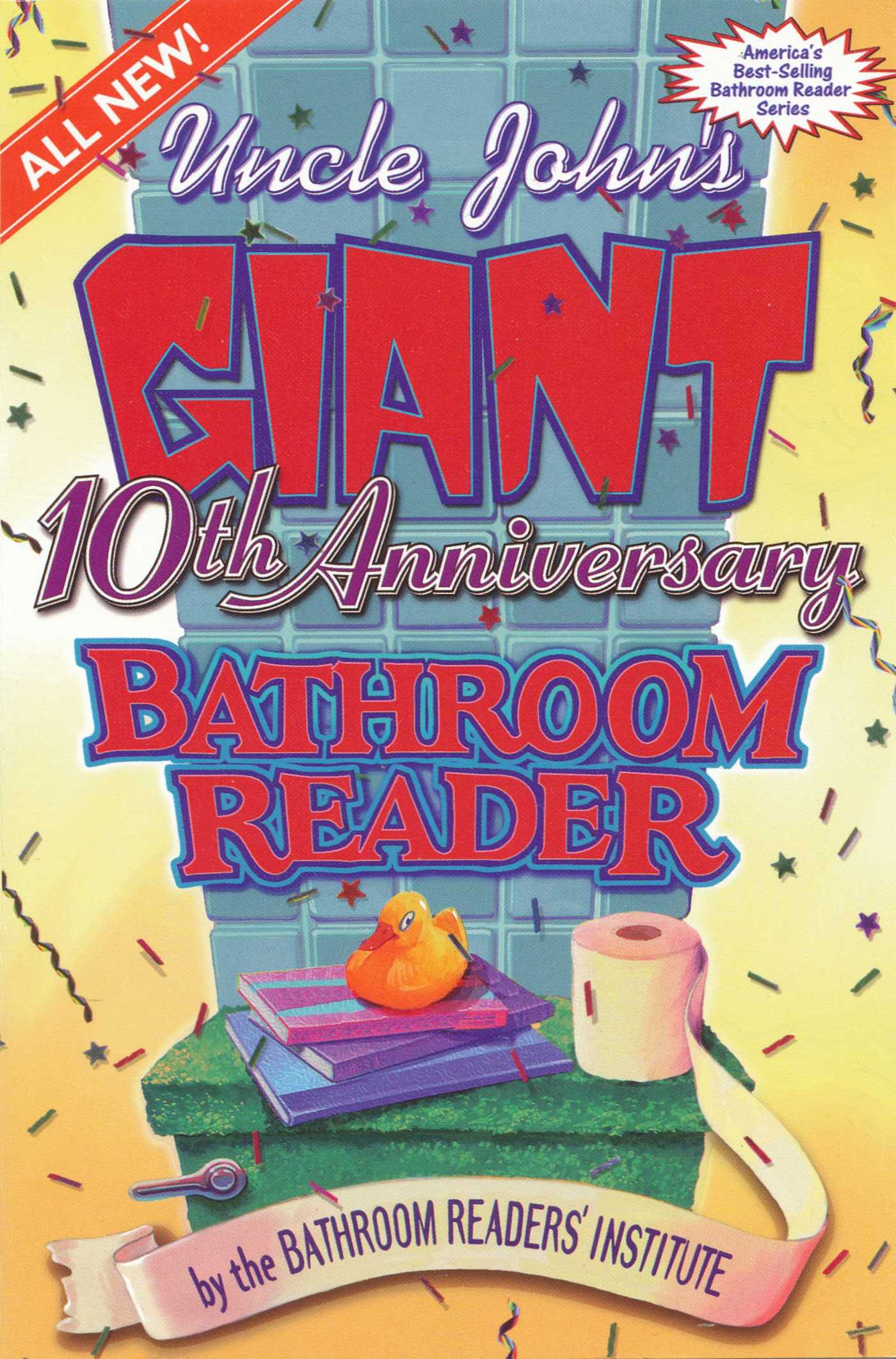 Image description: The cover of the 10th anniversary Bathroom Reader. The font, colour choices and general energy scream "I was published in 1997." End ID.
Image description: The cover of the 10th anniversary Bathroom Reader. The font, colour choices and general energy scream "I was published in 1997." End ID.
The big thing about the 10th anniversary one is that it had multiple super-long articles ("Extended Sitting Section"), which were broken up throughout the book in a nice serialised fashion. There was one on the different ways "light" beer had been advertised, which I still think about from time to time. But the one that I latched on to was about the history of milk pasteurisation. Neatorama has the article reprinted in its three parts if you're curious, it's a wild thing to put in a toilet reader but also interesting, approachable for a teen, short history and science articles weren't like, an easy thing to find at the time for me outside of these toilet books.
I ended up using that three-parter essay as the base of a short presentation I had to do for a science class. Something casual and not super cited, I guess. My teacher let me get all the way through the presentation and only then corrected my pronunciation of "faux," which I'd been saying like "fox," because I'd only ever read the word, never heard it, and had said it like a dozen times by that point.
Let's say I was 15 at the time I was like "food history is super interesting." I was also about 15 at the time I realised other people do not find food history as interesting as I do, but tough luck, that's what this is about, mostly, skip to the links and things at the end if you want.
Since sometime not long after that I've collected cookbooks and housewifery books. Did you know that folks were like "have you tried vinegar and baking soda to clean it" basically as long as we've had those things? I love household tip type books for their perfect window into what daily life was like for an era, what foods were normal, what fabrics were normal, what objects were normal in a house that were going to need cleaning, etc.
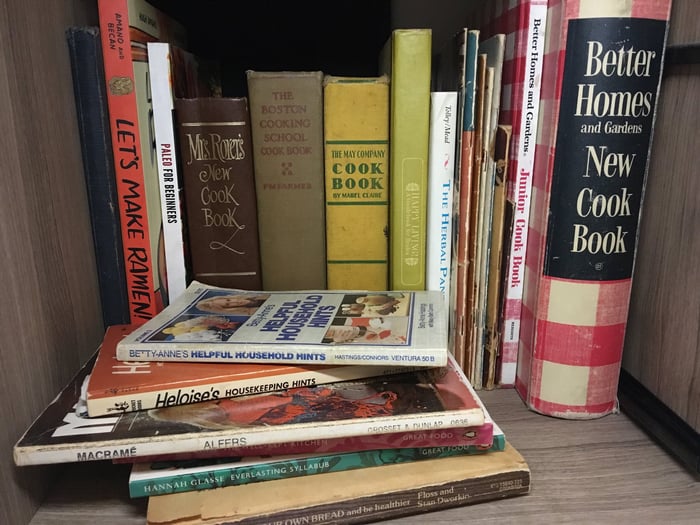 Image description: A photo of books on a shelf, some piled in front. They are a range of cook books, pamphlets and household hint books ranging from the 1920s to the 1990s. End ID.
Image description: A photo of books on a shelf, some piled in front. They are a range of cook books, pamphlets and household hint books ranging from the 1920s to the 1990s. End ID.
That picture isn't all of them, since the ones that see regular use are in the kitchen. The dark one on the far left is from 1928, published by the Royal Baking Powder Company, that is exceptional for having photographs for each step. I also have several reprints of householding books from earlier eras, like an abbreviated version of the 14th-century Le Ménagier de Paris. Because I've always had a bit of limited space, and a lot of books beyond this particular fancy, it's a small collection but one that I think focuses on some key eras. Very fun to see a book for a new bride from the 1960s be like "you will probably both be working, here are some tips to make meals easier, and here is how to buy a mattress."
They're little windows into time, a lovely example of how things change and how they stay the same. One thing you see a lot in the turn of industrialisation books, or those around times of increasing city life, is how to know the food you were getting was good food and not old or rotting. For all that I'd read them I hadn't been that hip on the greater history of food safety. But then I got a sinus infection.
I used to get sinus infections rather too often, but then we moved to where there were less allergy triggers and they became something that were rare instead of a twice-a-year hassle. Two-ish years ago I finally got one of The Big Ones, where you have to take antibiotics and also are useless because your head is full of quite a lot of snot that is slowly boiling in a fever.
Me and my handy library card turned to Hoopla, with its three-day rentals and a sturdy library of PBS titles. On a whim I grabbed something called The Poison Squad and then proceeded to watch it on a loop with one or two other documentaries as I drifted in and out of various states of healing naps. Like anything one encounters during a notable time, it became a comfort doc that I've watched a silly number of times since.
 Image description: A screencap of Hoopla rental history, showing several episodes of Ken Burns Prohibition, American Experience: The Poisoner's Handbook, and two back-to-back rentals of The Poison Squad. End ID.
Image description: A screencap of Hoopla rental history, showing several episodes of Ken Burns Prohibition, American Experience: The Poisoner's Handbook, and two back-to-back rentals of The Poison Squad. End ID.
When I met a Hoopla rep at the California Association Library Conference and he asked me what my favourite things on the app were, I said I watched mostly the same documentaries on repeat and quickly changed the subject to comics.
For all that I loved the doc, I am not an easy lover of non-fiction books, so it took me a while to get around to finally reading the book (same title, by Deborah Blum) the documentary is based from. Silly of me to wait, as it's as charming and interesting as the moving picture version and has lots more interesting context and history.
Beyond the food history of it all, one of the things that I get from the history of the Pure Food Movement and the history of food safety is long battle of it all. In Hannah Glasse's Everlasting Syllabub and the Art of Carving, from 1747, she guides the reader in choosing fresh meat at the butcher, because if the meat isn't coming from your lands then you can't know if it is sweet or tainted unless you check. The advent of canning and the swell of novel chemicals and their novel ways of use undermine the old ways of checking.
And it was very bad for a time, food safety. Quite a lot of people were poisoned in the name of profit. But people kept fighting for it, for health and for humans of all classes to eat safe food. And it got better. Things aren't perfect, as anyone who keeps an eye on FDA safety alerts is aware. But, we're not putting formaldehyde in milk nowadays, and labels have a lot of information that were never on them before. There's no fairy tale ending, where we can always trust sandwich sprouts and sliced meats. But we can trust them now more than we once could. And that's progress. That's good. And yes it could be better, but that's why we keep fighting, isn't it?
It's the same story for so many things. Prohibition, pushed by folks who wanted to make choices for others, and a amendment that many didn't think it would negatively affect them as much as it would. Leaded gas, which could be patented unlike less poisonous options, was a pure profit choice. They lasted a long time. And they still echo into today in more ways than we realise. Yet, in the end, they didn't last. There's hope there, among the poison.
Links go to the Storygraph entries for each title, a great place to check out content warnings and find ways to read them.
- Obviously, I gotta link you to The Poison Squad: One Chemist's Single-Minded Crusade for Food Safety at the Turn of the Twentieth Century by Deborah Blum, it's kind of central to this month's newsletter. If, like me, you're slow to read non-fiction, then you can check out the American Experience 2-hour documentary version of it, which you can get on Hoopla, which is free through most libraries in the States. It's a really interesting look at a lot of things happening in a chunk of history.
- Speaking of food, The Sad Bastard Cookbook by Rachel A. Rosen and Zilla Novikov is a gem and a joy and a very nice thing to give yourself or others. It's subtitled "A completely free cookbook for the zero spoons crowd." and you can pick up the ebook version for free over on Itch. It's well put together to manage decision fatigue, limited ingredients, limited skill, and low energy.
Because this is about food and my personal obsessions, I'm sharing a couple of my favourite snaps of the honestly S-tier cakes from the bakery case of a grocery store we used to live near. Truly nothing I've seen since matches the enthusiasm and imagination of this place. Know that these are actually some of the most basic I'm mad forever I can't find any photos of the real king of it: a burger and fries but in cake. Also, for enjoying these low-class snaps, you will be rewarded with something very cool at the end.
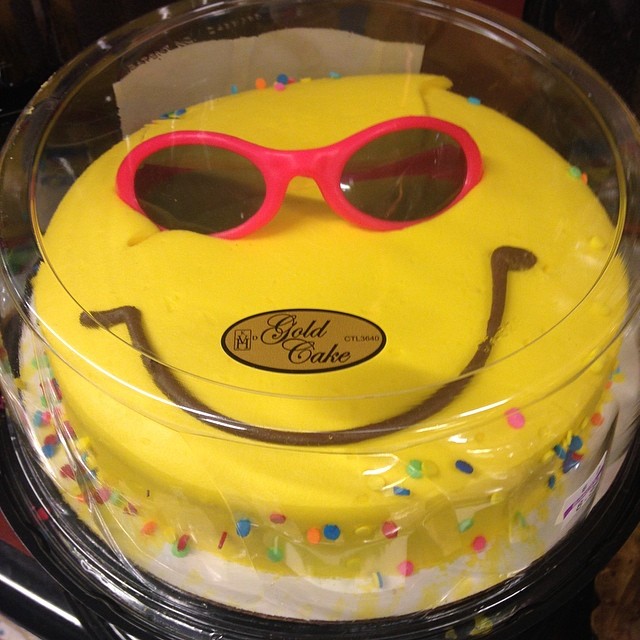 Image description: A snapshot of a round cake frosted in bright yellow. An icing smile stretches across the bottom and where the eyes would be, an actual pair of pink-framed sunglasses have been set into the cake. End ID.
Image description: A snapshot of a round cake frosted in bright yellow. An icing smile stretches across the bottom and where the eyes would be, an actual pair of pink-framed sunglasses have been set into the cake. End ID.
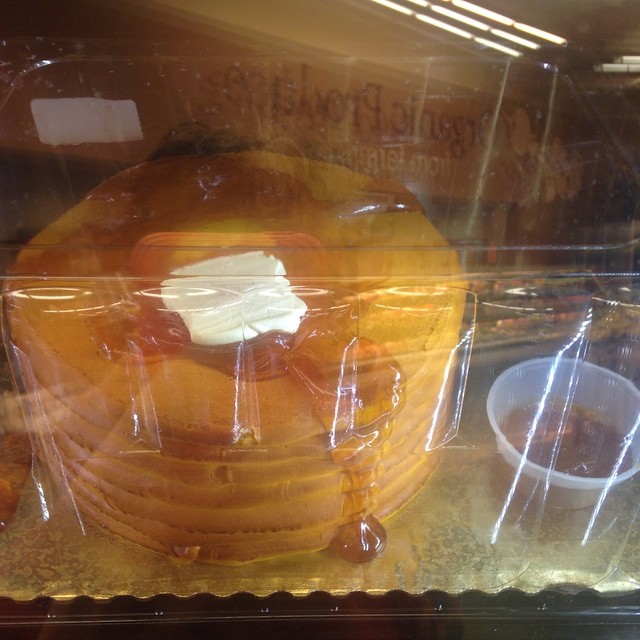 Image description: A snapshot of a cake, shot through a cooler case door so it really is indistinct. The cake has been frosted to resemble a stack of pancakes with a pat of butter on top. A clear, gel-like frosting has been added to give the impression of maple syrup. A dip container filled with more "syrup" is also on the cake board. End ID.
Image description: A snapshot of a cake, shot through a cooler case door so it really is indistinct. The cake has been frosted to resemble a stack of pancakes with a pat of butter on top. A clear, gel-like frosting has been added to give the impression of maple syrup. A dip container filled with more "syrup" is also on the cake board. End ID.
Thank you for looking at those cakes with me. I really love creative grocery store pre-mades. There was a fad for a while of monster cakes with frosting "fur" that you know dyed your tongue for longer than ideal. The obsession of cakes shaped like other food, as best one could do with the confines of time and supplies a grocery store bakery provided, was probably the acme of the edible wonders we'd find shopping at midnight and looking at the cakes filling the cases for the next day's round of impulse cake purchases.
Your reward:
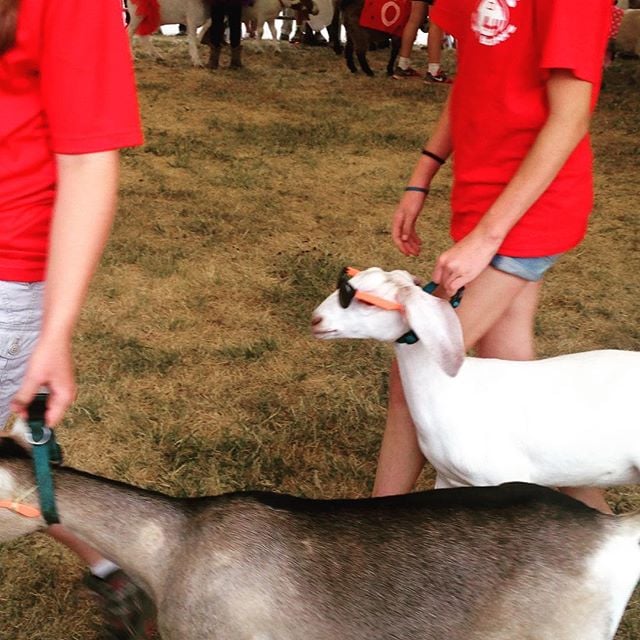 Image description: A snapshot of two people in red shirts leading goats. The humans are only visible from the shoulder-down, and one brown goat in the foreground is blurry because what matters is the white goat central to the image, a pair of children's sunglasses perched on their face. End ID.
Image description: A snapshot of two people in red shirts leading goats. The humans are only visible from the shoulder-down, and one brown goat in the foreground is blurry because what matters is the white goat central to the image, a pair of children's sunglasses perched on their face. End ID.
Some linky-loos:
- Rondo for Strings and Lasergun by Jared Oliver Adams, a tight 1200 words about music and the impossibility of putting away things one loves.
- I can't quite explain Powder Game, a physics-simulation game that works better on desktop browser than mobile. But it's simple and it is soothing. The other free games from Dan-Ball are also "retro" vibed, straightforward java type games that slap, frankly.
- The Rambler by Shen Dacheng, translated by Cara Healey, about a bridge and how silly order is as a concept.
- I probably haven't shared this site on letterlocking before because I was wanting something thematically aligned, but who cares. Letterlocking is so cool. It is as simple as the way some of us folded notes to pass in class and gets a level of complicated that surpasses expectations.
If you've thought of donating eSims, this guide was very helpful, and Crips for eSims for Gaza is a good option if you can't easily manage topping them up. There are also more traditional donation targets like the Palestine Children's Relief Fund, UNRWA, and Doctors Without Borders. If you prefer giving directly to families, Gaza Funds is a nice resource that facilitates finding campaigns.